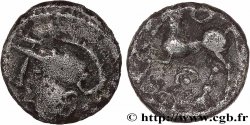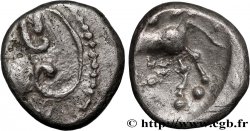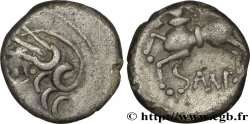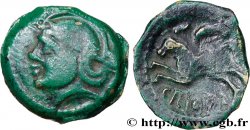bga_472576 - GALLIA - ÆDUI (BIBRACTE, Area of the Mont-Beuvray) Quart de statère au bige et à la lyre
无库存.
所有在网站上销售的产品 (2018)
价格 : 2 800.00 €
所有在网站上销售的产品 (2018)
价格 : 2 800.00 €
种类 Quart de statère au bige et à la lyre
日期: Ier siècle avant J.-C.
铸币厂名称/城市 Autun (71)
材质 gold
直径 11 mm
模子方针 1 h.
重量 1,95 g.
稀少度 R3
关于品相的说明
Superbe petite monnaie avec des types complets et de frappe vigoureuse. Malheureusement, trois petits coups assez profonds sont à signaler au revers
出版目录中的项代码 :
家谱
Cet exemplaire provient de la collection Raymond D. (1948-2017), il a été acquis auprès C. N. B. en novembre 1992 (5.000 fr).
正面
正面的文字 ANÉPIGRAPHE.
正面的说明书 Tête à droite, la chevelure en grosse mèches enroulées ; un globule sur le front.
背面
背面的文字 ANÉPIGRAPHE.
背面的说明书 Bige à gauche, un épi sous les chevaux, conduit par un aurige en bord de flan, avec la roue du char visible.
评论
L’attribution de ce type de quart semble osciller plus ou moins arbitrairement entre les Arvernes et les Éduens. Castelin classe celui du musée de Zurich dans les Séries moyennes des imitations de Philippe II. Les exemplaires DT. 3381-3382 constituent le Type II “à la lyre et à l’épis” (?) alors qu’aucune de ces monnaie n’a d’épis... Ces deux quarts sont d’un type comparables au DT. 3379A. Le n° 59 du musée de Caen est très proche, mais issu d’un coin de droit usé, comme le DT. 3381 (= BN. 4838 illustré dans le La Tour). Il est surprenant que ce type ne soit pas repris dans l'article de D. Allen sur les monnaies d’or imitées de Philippe dans la Revue Suisse de Numismatique de 1974.
Un exemplaire de même type que notre quart, mais un peu moins joli, a été vendu 1.800€ dans la vente ALDE du 14 juin 2010, Collection d’un Amateur Bourguignon, n° 1.
The attribution of this type of quarter seems to oscillate more or less arbitrarily between the Arverni and the Aedui. Castelin classifies the one in the Zurich museum in the Middle Series of imitations of Philip II. The examples DT. 3381-3382 constitute Type II “with lyre and ear of corn” (?) while none of these coins have ears of corn... These two quarters are of a type comparable to DT. 3379A. No. 59 in the Caen museum is very similar, but comes from a worn obverse die, like DT. 3381 (= BN. 4838 illustrated in La Tour). It is surprising that this type is not included in D. Allen's article on the imitated gold coins of Philippe in the Revue Suisse de Numismatique of 1974. A example of the same type as our quarter, but a little less attractive, was sold for €1,800 in the ALDE sale of June 14, 2010, Collection of a Burgundian Amateur, No. 1
Un exemplaire de même type que notre quart, mais un peu moins joli, a été vendu 1.800€ dans la vente ALDE du 14 juin 2010, Collection d’un Amateur Bourguignon, n° 1.
The attribution of this type of quarter seems to oscillate more or less arbitrarily between the Arverni and the Aedui. Castelin classifies the one in the Zurich museum in the Middle Series of imitations of Philip II. The examples DT. 3381-3382 constitute Type II “with lyre and ear of corn” (?) while none of these coins have ears of corn... These two quarters are of a type comparable to DT. 3379A. No. 59 in the Caen museum is very similar, but comes from a worn obverse die, like DT. 3381 (= BN. 4838 illustrated in La Tour). It is surprising that this type is not included in D. Allen's article on the imitated gold coins of Philippe in the Revue Suisse de Numismatique of 1974. A example of the same type as our quarter, but a little less attractive, was sold for €1,800 in the ALDE sale of June 14, 2010, Collection of a Burgundian Amateur, No. 1








 对产品描述纠错
对产品描述纠错 打印
打印 分享我的选择
分享我的选择 提问
提问 Consign / sell
Consign / sell
 产品介绍
产品介绍














